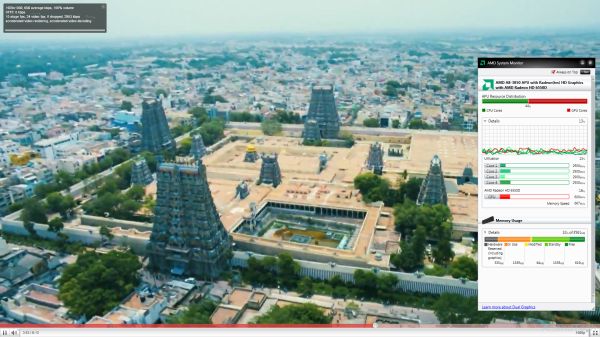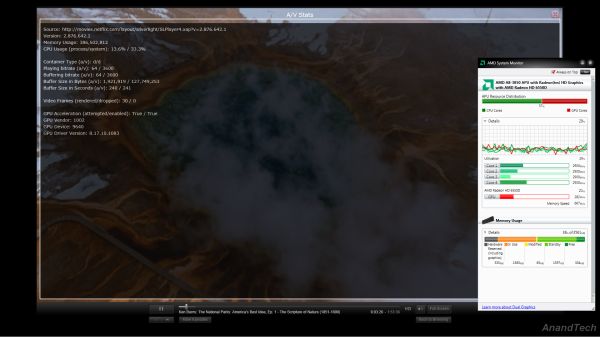AMD A8-3850 : An HTPC Perspective
by Ganesh T S on June 30, 2011 6:20 AM EST
3D Blu-ray Playback CPU Load
We saw in one of the previous sections that the 6550D doesn't have the same MVC decode feature of the 6xxx GPUs. We took the 3D Blu-ray version of Alice in Wonderland for a spin and played it on the 6550D as well as the 6570 (not in CrossFire mode). As expected, the 6570 had marginally lesser CPU utilization. The GPU load (not recorded here) was also lesser compared to the 6550D (that is to be expected because of the difference in the DRAM and GPU core clocks). We also recorded the CPU load while playing a 2D Blu-ray (HQV Benchmark) on the 6550D. It gives an indication of the CPU assistance required by the 3D Blu-rays.
| Blu-ray Playback CPU Usage | ||
| Alice in Wonderland [3D] (6550D) | 21% | |
| Alice in Wonderland [3D] (Sapphire 6570) | 16% | |
| HQV 2.0 Benchmark Blu-ray [2D] (6550D) | 12% | |
Steady Video
AMD is also advertising 'Steady Video', a feature to make your shaky hand held videos such as those from the PlaySports and the Flips look more stabilized. This requires the CPU and the GPU to work in close conjunction. The good aspect is that 'Steady Video' is available even when playing back videos in MPC-HC. For reasonably steady videos, it works wonders, but fails in places where it really matters (like videos taken while walking, where there is a lot of scene change as well as shakiness). The bad aspects come in when one tries to be aggressive with the steady video algorithms. Sometimes, the image quality suffered, while there were lip sync errors in other cases. Even in videos where it is effective, there are slight periodic jerks.
All in all, our opinion is that this is a good feature for the marketing department to advertise. Note that Cyberlink has been having a True Theater Image Stabiliser for camcorder videos since PowerDVD 10. That feature works across all CPU / GPU combinations.
YouTube and Netflix
The good news is that hardware acceleration is present and works for both YouTube and Netflix, as the screenshots below show.
Power Numbers
We put our testbed through some typical activity and recorded the average power consumption numbers. Note that these numbers are relevant only when compared with the idle playback power consumption. Different testbeds may end up with different power consumption numbers.
| Llano HTPC Testbed Average Power Consumption (W) | ||
| Idle | 36.1 | |
| 1080p MKV from SSD | 49.1 | |
| 2D Physical Blu-ray Playback | 57.1 | |
| Call of Pripyat Benchmark (Max. settings) | 91.8 | |
| Prime 95 + Furmark | 141.2 | |
Miscellaneous Notes
We are yet to evaluate some important aspects like RGB - YUV colour conversion accuracy and audio channel mapping in 7.1 channel configurations. AMD is looking into the local file playback having high GPU load issue also. By the time we evaluate the next HTPC / HTPC GPU, some Catalyst releases should have passed by. Expect further analysis of the AMD 6550D in those pieces, particularly with respect to the aspects we have missed covering in this review.












104 Comments
View All Comments
ckryan - Thursday, June 30, 2011 - link
There's lots of good stuff to do with a GPU that doesn't involve games; unfortunately, it seems like that is the only thing AMD had in mind for the Llano GPU. It's unfortunate, since running a discrete GPU with Llano in its desktop form just seems to make Llano pointless. In a laptop you at least get decent game performance at low screen resolutions.My enthusiasm for the future of Llano isn't diminished, but strangely, it seems that Llano makes a cheap Phenom II + dGPU seem like a much better idea than it was yesterday.
Still, with some Bulldozer cores, improved GPU section, and some better drivers will go a long way to making Llano mainstream vs. a super-niche product for the desktop.
duploxxx - Thursday, June 30, 2011 - link
a super niche product for the desktop..... did you ever went to any large electronic shop? it's full of these kind of designs that you brand "niche". Check few OEM very soon they will all bulk this kind of Liano setups.... just like Brazos was a success this will also and already a major reason why intel introduces the 2105 just at release of Liano.... but the HD3000 over HD2000 remains crap.L. - Thursday, June 30, 2011 - link
You don't get it, the guy above is right !!!It's a super-niche product, for the biggest niche there is in the whole consumer market, normal people.
Gee AMD ... bad idea really ;)
Ananke - Thursday, June 30, 2011 - link
:) Llano is exactly what the mass-consumer grade computer market uses and needs. That's 99.5% of the total market. The other negligible 0.5% is enthusiast market, where most of the AnandTech readers belong. Intel is still king there.therealnickdanger - Thursday, June 30, 2011 - link
"However, this leads to increased expectations like support for full post processing on Blu-ray videos."Did I misunderstand the comment?
Assuming a faithful transfer from film (16mm/35mm/65/70mm) to Blu-ray (1080p24), there should be absolutely no reason to apply any post-processing to a Blu-ray. The worst transfers are those cases where the studio applied processing prior to encoding on the Blu-ray, and then there is no recourse to undo the effects. With only a handful of examples of low-budget or foreign films, there are no interlaced Blu-rays. And then, you would only need deinterlacing, not post-processing. Any artificial sharpening, coloring, or smoothing will ultimately degrade picture quality, not improve it. Outside of playing back Blu-rays in the proper color space and eliminating judder, not much else should be done to them.
ganeshts - Thursday, June 30, 2011 - link
Sorry if I wasn't clear in this respect. I had also mentioned in the HQV section that we believe Blu-rays don't need post processing.First, there are a lot more interlaced Blu-rays than we would actually expect. Loads of nature documentaries and concerts are available in 1080i60. While the former ones are mostly VC-1, the latter Blu-rays are all H.264
AMD's main stance with respect to not supporting 1080p60 camcorders was the fact that they want to target the Blu-ray market mainly. Now, 1080i60 is less demanding than 1080p60, and is also present in many camcorders which are already in the $200 - $300 range. If Llano GPUs don't support post processing on 1080i60 fully, I think it is a long way off before they start supporting 1080p60 decode along with post processing. So, the 'even for Blu-rays' comment is meant to stress that aspect rather than mean that we actually need the post processing for Blu-ray videos. (Local files were the main target of my post processing tests)
therealnickdanger - Thursday, June 30, 2011 - link
Understood, thanks for taking the time to respond!StormyParis - Thursday, June 30, 2011 - link
for a very detailed review. I don't know much about HTPCs to start with, and I'm left a bit overwhelmed and confused, though.First, I really don't think the current Llano is meant to be used with a discrete graphics card. I think the whole point of the product, and the only situation in which it's worth coping with their underpowered CPU / higher power draw, is if I actually take advantage of their GPU.
Second, I'm not really clear which issues are fixable in software, and which will stay. Actually, I'm not really clear which issues are important, and which aren't.
Third, It'd be nice to have a hint about what lower clocks / core counts will do. I'd rather use 65W parts for small enclosures, and I have the feeling that wouldn't change much, but I'm not sure.
geniekid - Thursday, June 30, 2011 - link
Sounds to me like, if they fixed their software issues, AMD would be the preferred platform for HTPC.ganeshts - Thursday, June 30, 2011 - link
Yes, let us wait and watch for a couple of driver releases